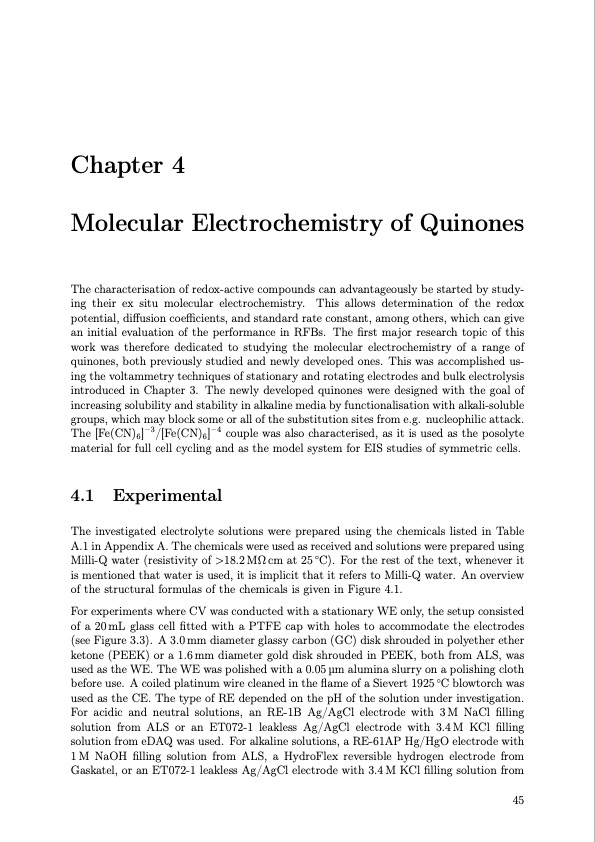
PDF Publication Title:
Text from PDF Page: 066
Chapter 4 Molecular Electrochemistry of Quinones The characterisation of redox-active compounds can advantageously be started by study- ing their ex situ molecular electrochemistry. This allows determination of the redox potential, diffusion coefficients, and standard rate constant, among others, which can give an initial evaluation of the performance in RFBs. The first major research topic of this work was therefore dedicated to studying the molecular electrochemistry of a range of quinones, both previously studied and newly developed ones. This was accomplished us- ing the voltammetry techniques of stationary and rotating electrodes and bulk electrolysis introduced in Chapter 3. The newly developed quinones were designed with the goal of increasing solubility and stability in alkaline media by functionalisation with alkali-soluble groups, which may block some or all of the substitution sites from e.g. nucleophilic attack. The [Fe(CN)6]–3/[Fe(CN)6]–4 couple was also characterised, as it is used as the posolyte material for full cell cycling and as the model system for EIS studies of symmetric cells. 4.1 Experimental The investigated electrolyte solutions were prepared using the chemicals listed in Table A.1 in Appendix A. The chemicals were used as received and solutions were prepared using Milli-Q water (resistivity of >18.2 MΩ cm at 25 ◦C). For the rest of the text, whenever it is mentioned that water is used, it is implicit that it refers to Milli-Q water. An overview of the structural formulas of the chemicals is given in Figure 4.1. For experiments where CV was conducted with a stationary WE only, the setup consisted of a 20mL glass cell fitted with a PTFE cap with holes to accommodate the electrodes (see Figure 3.3). A 3.0 mm diameter glassy carbon (GC) disk shrouded in polyether ether ketone (PEEK) or a 1.6 mm diameter gold disk shrouded in PEEK, both from ALS, was used as the WE. The WE was polished with a 0.05 μm alumina slurry on a polishing cloth before use. A coiled platinum wire cleaned in the flame of a Sievert 1925 ◦C blowtorch was used as the CE. The type of RE depended on the pH of the solution under investigation. For acidic and neutral solutions, an RE-1B Ag/AgCl electrode with 3M NaCl filling solution from ALS or an ET072-1 leakless Ag/AgCl electrode with 3.4M KCl filling solution from eDAQ was used. For alkaline solutions, a RE-61AP Hg/HgO electrode with 1M NaOH filling solution from ALS, a HydroFlex reversible hydrogen electrode from Gaskatel, or an ET072-1 leakless Ag/AgCl electrode with 3.4 M KCl filling solution from 45PDF Image | Organic Redox Flow Batteries 2023

PDF Search Title:
Organic Redox Flow Batteries 2023Original File Name Searched:
PhD_thesis_final_dorhoff_4_.pdfDIY PDF Search: Google It | Yahoo | Bing
Salgenx Redox Flow Battery Technology: Salt water flow battery technology with low cost and great energy density that can be used for power storage and thermal storage. Let us de-risk your production using our license. Our aqueous flow battery is less cost than Tesla Megapack and available faster. Redox flow battery. No membrane needed like with Vanadium, or Bromine. Salgenx flow battery
| CONTACT TEL: 608-238-6001 Email: greg@salgenx.com | RSS | AMP |